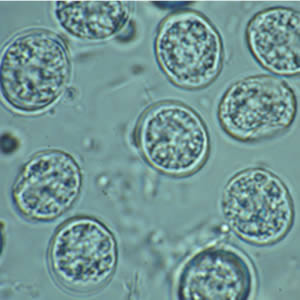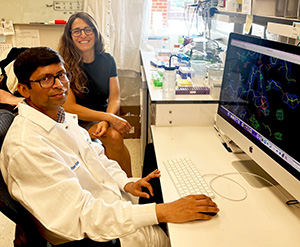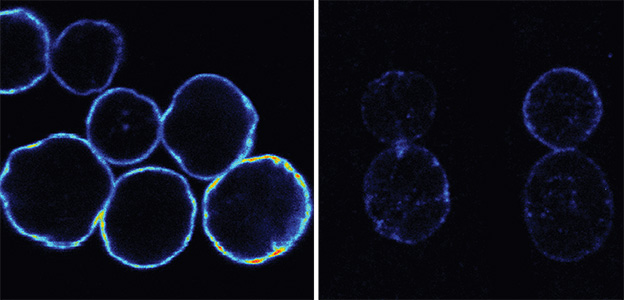Finding a Way To Weaken a Stubborn Parasite
Enzyme structure reveals potential targets for eradicating dormant Toxoplasma infection
In Brief:
- NIDCR scientists revealed the structure of an enzyme needed by the infectious parasite Toxoplasma gondii to build long-lasting cysts in host organisms.
- By comparing the parasite’s enzyme to a similar version found in humans, investigators found several differences that could be exploited as drug targets to weaken these cysts.
The single-celled parasite Toxoplasma gondii is best known for being the reason pregnant people are advised against cleaning litter boxes — T. gondii infection can be picked up by handling cat feces. In developing countries, T. gondii commonly causes foodborne illness when people eat raw or undercooked meat from infected livestock. In the human body, the parasite can take the form of an infectious, free-floating pathogen, or as a cyst embedded in nerve or muscle tissue. The infectious form can be treated with medications. But the cysts are impenetrable to drugs, remaining permanent residents in human tissue. In people with weakened immune systems, these cysts can repeatedly transition back to the infectious form throughout the lifespan, which can damage organs or even lead to death.
A research team led by NIDCR Stadtman Tenure-Track Investigator and Distinguished Scholar Nadine Samara, Ph.D., and postdoctoral fellow Pranav Kumar, Ph.D., determined the molecular structure of an enzyme essential for the integrity of the T. gondii cyst wall. When they compared the version of the enzyme found in T. gondii to the one found in humans, they identified several key differences that could be exploited as drug targets. The results, published in the journal Nature Communications, suggest that newer, more effective therapies targeting this enzyme could be designed to weaken the cysts, allowing traditional T. gondii medications to penetrate.
“When investigators design new treatments against infections, they try to ensure that the drugs don’t interact strongly with any human proteins; otherwise, there’s a risk for harmful side effects,” said Dr. Samara. “This is why structural biology work can be important for establishing the foundation for more targeted drug design.”
The T. gondii cyst wall is made of proteins that are decorated with large groups of sugars that contribute to the proteins’ shape and function. The enzyme that adds these sugars to the cyst wall proteins is called O-GalNAc transferase-3, or GalNac-T3.
Dr. Samara and her team used an imaging method called X-ray crystallography to determine the molecular structure of T. gondii GalNac-T3. Then they compared it with the corresponding enzyme in humans. Although each enzyme had the same overall structure, there were some key differences. The T. gondii enzyme has an extra site that binds to the metal manganese that is not found in human versions of the enzyme. The T. gondii enzyme also has a longer tail than the human versions. Finally, the T. gondii enzyme has an additional structure that binds to sugars on cyst wall proteins that is not found in human enzymes.
To discern the importance of these differences on the function of the T. gondii GalNac-T3 enzyme, Dr. Samara and her lab teamed up with Louis M. Weiss, M.D., M.P.H., and Tadakimi Tomita, Ph.D., of the Albert Einstein College of Medicine. The team mutated T. gondii GalNac-T3 in the region where it binds to the extra manganese and in its long tail. Next, they tested the mutant enzymes’ activity by looking at the structural integrity of the T. gondii cyst wall. The researchers found that mutations in both locations weakened cyst wall formation.
Dr. Samara said that the T. gondii enzyme is more like those found in other parasites such as Cryptosporidium than it is the human versions, which means that any therapies developed for T. gondii may be useful for treating other parasitic infections as well.
“A third of our world’s population is thought to be infected with Toxoplasma gondii. In countries with large populations of people with weakened immune systems due to HIV, the repeated infections caused by established T. gondii tissue cysts remain a significant public health concern,” said NIDCR Deputy Director Jennifer Webster-Cyriaque, D.D.S., Ph.D. “Foundational studies like these can support future therapeutics that will help us reach a point where lifetime parasitic infections may become a thing of the past.”
Related Links
- Mapping Mucus in a Mouse
- Scientists Identify Mechanism That May Influence Infectivity of SARS-CoV-2 Variants
Reference
- Kumar P, Tomita T, Gerken TA, Ballard CJ, Lee YS, et al. A Toxoplasma gondii O-glycosyltransferase that modulates bradyzoite cyst wall rigidity is distinct from host homologues. Nat Commun. 2024 May 6;15(1):3792. doi: 10.1038/s41467-024-48253-w.
Attention Editors
Reprint this article in your own publication or post to your website. NIDCR News articles are not copyrighted. Please acknowledge NIH's National Institute of Dental and Craniofacial Research as the source.
Subscribe for NIDCR Updates
Receive email updates about the latest advances in dental, oral, and craniofacial research.
October 2024



